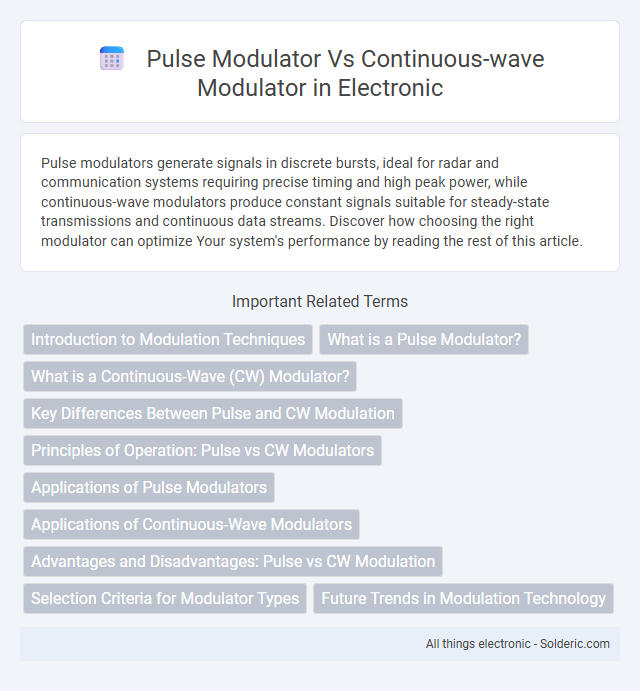Pulse modulators generate signals in discrete bursts, ideal for radar and communication systems requiring precise timing and high peak power, while continuous-wave modulators produce constant signals suitable for steady-state transmissions and continuous data streams. Discover how choosing the right modulator can optimize Your system's performance by reading the rest of this article.
Comparison Table
| Feature | Pulse Modulator | Continuous-Wave Modulator |
|---|---|---|
| Output Signal | Short pulses of energy | Continuous, uninterrupted wave |
| Operation Mode | Intermittent, time-controlled | Steady, constant output |
| Power Efficiency | High peak power, lower average power | Constant power, lower peak power |
| Applications | Radar, LIDAR, pulsed laser systems | Telecommunications, continuous laser operation |
| Complexity | Requires precise timing control | Simpler design, steady operation |
| Thermal Management | Easier due to intermittent power | Challenging due to continuous heat generation |
Introduction to Modulation Techniques
Pulse modulators generate discrete bursts of signals with varying amplitude, width, or position, enabling precise control in radar and communication systems. Continuous-wave modulators produce a steady, uninterrupted signal whose amplitude, frequency, or phase is varied to encode information, often utilized in radio broadcasting and continuous signal transmission. Both modulation techniques are essential for tailoring signal characteristics to specific applications, balancing power efficiency and data fidelity.
What is a Pulse Modulator?
A pulse modulator generates short bursts of high-power pulses by rapidly switching the output signal on and off, enabling precise control over the timing and duration of each pulse. It is widely used in radar systems, laser applications, and high-power transmitters to deliver energy in discrete intervals, enhancing signal resolution and reducing heat dissipation compared to continuous-wave modulators. Unlike continuous-wave modulators that provide a constant output signal, pulse modulators optimize efficiency and performance in applications requiring time-gated energy delivery.
What is a Continuous-Wave (CW) Modulator?
A Continuous-Wave (CW) modulator generates a constant, unbroken electromagnetic signal, essential for applications like radar and communication systems requiring steady signal transmission. Unlike pulse modulators that produce intermittent bursts, CW modulators maintain continuous waveforms, ensuring stable frequency and amplitude. Your choice between pulse and CW modulators depends on whether you need consistent signal output or time-gated pulses for specific operational needs.
Key Differences Between Pulse and CW Modulation
Pulse modulators generate discrete bursts of energy with defined durations and intervals, enabling time-domain control crucial for radar and digital communication systems, while continuous-wave (CW) modulators produce a constant, uninterrupted signal ideal for applications requiring steady amplitude, such as continuous-wave radar and optical communication. Pulse modulation offers high peak power with lower average power consumption, whereas CW modulation maintains consistent power output for reliable signal transmission. The fundamental difference lies in temporal behavior: pulse modulation emphasizes transient signal generation, contrasting with CW modulation's steady-state waveform.
Principles of Operation: Pulse vs CW Modulators
Pulse modulators operate by generating short bursts of energy at precise intervals, allowing high peak power delivery with minimal average power consumption. Continuous-wave (CW) modulators provide a constant, steady signal output, ideal for applications requiring uninterrupted transmission. Your choice depends on whether your system benefits more from high peak power pulses or a stable continuous signal.
Applications of Pulse Modulators
Pulse modulators are widely used in radar systems, laser communication, and medical imaging due to their ability to generate high-peak power pulses with precise timing control. These modulators enable efficient time-domain signal processing and reduce power consumption compared to continuous-wave modulators, making them ideal for applications requiring short, high-energy bursts. Pulse modulators also play a crucial role in particle accelerators and high-power microwave generation where controlled pulse shaping enhances system performance.
Applications of Continuous-Wave Modulators
Continuous-wave modulators are essential in telecommunications for steadily encoding information onto carrier waves, ensuring reliable signal transmission over long distances. They are widely used in laser systems for material processing and medical diagnostics, where precise frequency control and stable output are critical. Your optical communication systems benefit significantly from continuous-wave modulators due to their low noise and high modulation efficiency.
Advantages and Disadvantages: Pulse vs CW Modulation
Pulse modulators offer precise control over signal timing, enabling efficient power usage and reduced thermal stress, making them ideal for radar and digital communications; however, they can introduce complexity and require sophisticated timing circuits. Continuous-wave (CW) modulators provide steady output and simpler design, suitable for applications needing constant power like broadcasting and continuous-wave radar, but they often consume more energy and generate more heat. Your choice between pulse and CW modulation depends on balancing the need for timing precision against power efficiency and system complexity.
Selection Criteria for Modulator Types
Selection criteria for pulse modulators versus continuous-wave modulators depend primarily on the application's power efficiency, signal integrity, and modulation speed requirements. Pulse modulators are preferred for radar systems and high-power applications due to their ability to handle high peak power with precise timing control, while continuous-wave modulators excel in communication systems requiring stable, continuous signals with low phase noise and linearity. Key factors influencing choice include desired duty cycle, bandwidth, thermal management, and compatibility with the transmission medium.
Future Trends in Modulation Technology
Future trends in modulation technology emphasize the integration of pulse modulators and continuous-wave modulators with advanced digital signal processing and machine learning algorithms to enhance signal clarity and power efficiency. Innovations in semiconductor materials and nanotechnology are set to improve the speed, precision, and miniaturization of modulators, making them more adaptive to varying signal environments in 5G and beyond. Your communication systems can achieve higher bandwidth and lower latency by leveraging these cutting-edge modulation techniques tailored for emerging wireless and satellite networks.
Pulse modulator vs continuous-wave modulator Infographic

 solderic.com
solderic.com